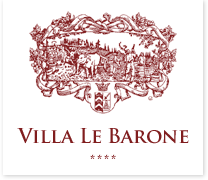
Ending a nice meal with Vin Santo (Holy Wine) and Cantucci , as many Tuscans do, is quite a treat!
This is what you can enjoy at Villa le Barone, in Chianti, when you are finishing your dinner under the beautiful chandeliers in the restaurant, or on the terrace, for the candlelight dinner. Dip your “cantucci” for 5 second or so, in the Holy wine. They become sweetly moist, savor them …and drink the remaining of the Vin Santo.But what is “Vin Santo”, and what are “Cantucci “?
Vin Santo or Vino Santo (holy wine) is a traditional dessert wine in Tuscany, usually made from white grape varieties such as Trebbiano and Malvasia. Grapes destined for Vin Santo are harvested late, in October. They are afterwards hung or put on mats of reed in warm, well-ventilated rooms that allow the moisture in the grape to evaporate, allowing the sugars in the grape to be more concentrated. It is worth mentioning at this stage that Villa le Barone, when it was a farm at the beginning of the 20th century, was producing Vin Santo, and the grapes were hung in what is now the “ Garden House” ! Depending on the characteristics of wine desired, the grapes are crushed after a few weeks, from December until late March. The fermentation process then starts, and the wine is put for aging in small oak barrels of around 200 liters. The appellation DOC (Denominazione di Origine Controllata) requires that the wines age for at least 3 years, and it is not uncommon for producers to age their wines for 5 to 10 years.
There are many theories as to how Vin Santo, or “Holy Wine” got its name. One of them is of course that the name was derived from the wine’s use and association with the sacrament of the Eucharist. Another theory is that, when the Greek island of Santorini came under rule of the Ottoman Empire, the ruling Turks encouraged the island’s wine production of a sweet dessert wine made from dried grapes and the word “Santo “comes from the abbreviation of “Santorini” . Another story tells that a 14th-century friar from the province of Siena would use the leftover wine from Mass to cure the sick. Miraculous healings became associated with the santo or “holy” wine and the name Vin Santo was allegedly born.
At Villa le Barone we serve an 8 years age Vin Santo del Chianti DOC produced by the Fattoria di Lucignano, at about ½ h drive from Villa le Barone. It has a beautiful amber yellow color, and an intense and complex smell of dried fruit, apricot, honey, and acacia flowers.

As for the Cantucci (or cantuccini, which would mean small Cantucci) that have to be dipped in the Vin Santo , they are delicately sweet, crisp almond cookies. They are also called “biscotti di Prato”, the word “biscotti coming from the Latin word “biscoctus”, meaning “twice-baked.” Those biscuits are obtained slicing a warm loaf of dough containing the almonds. The first documented recipe for this biscuit is in a 18th century document by,Amadio Baldanzi, preserved in Prato. The recipe was then taken up by the pastry chef Antonio Mattei in the nineteenth century, and since then it has remained as such, making it the traditional recipe that distinguishes the original biscuits of Prato from numerous modern variations. The same pastry chef brought the cookies at the Universal Exhibition in Paris in 1867, winning a special mention. The mixture is composed exclusively of flour, sugar, eggs, almonds and pine nuts. Almonds are neither roasted nor blanched. There is no use or any kind of yeast or fat (butter, oil, milk).
